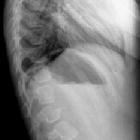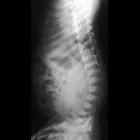anterior vertebral body beaking

Deformierte
Wirbelkörper thorakolumbaler Übergang bei Achondroplasie. Die Vorderkante ist ausgerundet, die Hinterkante zeigt ein Scalopping.

Anterior
vertebral body beaking • Anterior vertebral beaking secondary to trauma - Ganzer Fall bei Radiopaedia

Preschooler
with short stature. AP radiograph of the lumbar spine (left) shows progressive narrowing of the distance between the pedicles descending through the lumbar spine (interpedicular narrowing). The lateral radiograph of the lumbar spine (right) shows shortened pedicles leading to narrowing of the anterior-posterior diameter of the spinal canal (spinal stenosis) and that the vertebral bodies have some anterior wedging and posterior scalloping.The diagnosis was achondroplasia.

Preschooler
with short stature. Lateral radiograph of the spine shows kyphosis of the thoracolumbar spine and shortened pedicles, posterior scalloping of vertebral bodies and anterior beaking of vertebral bodies.The diagnosis was achondroplasia.

An unusual
presentation of fucosidosis in a Chinese boy: a case report and literature review (childhood fucosidosis). Anterior lateral radiograph of the spine of the patient. A concave proximal ends of the ribs, the irregular shape of the centrum and bilateral shallow acetabulum with irregular margin; (B) and (C) anterior beaking of the lower thoracic and lumbar vertebrae
Anterior vertebral body beaking occurs in a number of conditions and may emanate from the central portion or the lower third of the vertebral body.
Middle third
- Morquio syndrome (middle for Morquio)
Lower third
- Hurler syndrome
- achondroplasia
- pseudoachondroplasia
- cretinism
- Down syndrome
- neuromuscular diseases
Siehe auch:
und weiter:

 Assoziationen und Differentialdiagnosen zu anterior vertebral body beaking:
Assoziationen und Differentialdiagnosen zu anterior vertebral body beaking:


